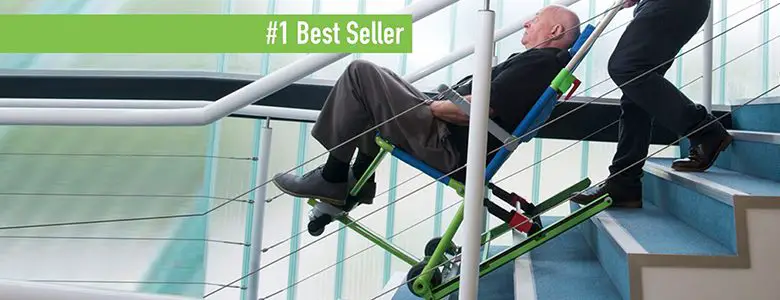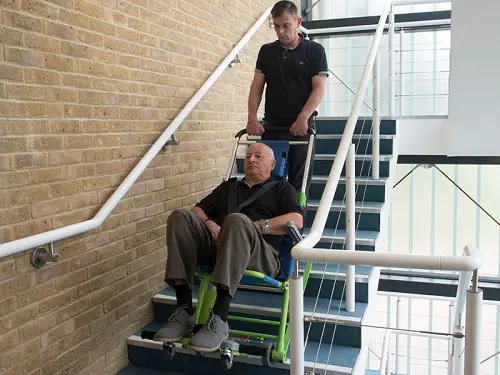
How does a wheelchair user or otherwise mobility impaired person escape from a burning building?
As a disabled person, you may have found yourself in the unfortunate situation of being stuck at the top of a set of stairs, wondering how to navigate your way to the ground floor. Even if you haven’t, it might have crossed your mind. To ensure you never get stuck in that predicament, Evacusafe explains the range of rescue-assistance products available for businesses and individuals at home.
If you have ever thought about being in an emergency situation where your only available escape route to safety is via the inaccessible stairway, it’s quite possible that strong emotions were brought to bear, including fear, helplessness or perhaps bewilderment. All of which are entirely natural feelings to experience in such circumstances.
But the good news is that there are simple, safe and effective solutions available to assist you in such a situation. Specialist equipment has been specifically designed to facilitate the safe evacuation of people with mobility impairments can be put in place. Staff can also be professionally-trained, so you know they’re both competent and confident in how to use that equipment correctly. Surely this knowledge would help you feel more at ease?


Thankfully, legislation designed to prevent this type of scenario from happening has also been in place for a number of years. Two acts, in particular, exist to protect members of the disabled community. The Regulatory Reform (Fire Safety) Order 2005 and The Equality Act 2010. Both require all business premises to provide an equal chance of a safe escape for EVERYONE, regardless of disability.
The type of premises that must abide by these laws include (but are not limited to):
- banks;
- libraries;
- hospitals;
- care homes;
- restaurants;
- places of work;
- public buildings;
- government buildings;
- shops and shopping centres;
- schools, colleges and universities;
- hotels and guest houses –basically any structure with upper floors.
As a leading manufacturer of evacuation chairs and equipment, we at Evacusafe UK have a product portfolio of such specialist equipment. We supply thousands of units across the globe and the company’s name is becoming synonymous with providing safety equipment for people with mobility impairments.
Below is an introduction to some of the equipment we have designed and manufactured, so that you know what to look for when you’re out and about or at work or school, and what to ask for should the need arise.
Evacuation chairs
This is by far our top-selling piece of equipment. Often found at the top of stairways, hanging on brackets or folded flat against the wall, evacuation chairs are quick and easy to set up. They utilise a pair of special tracks, which use traction in order to grip the edge of the stairs on the descent. The evacuee is safely strapped in and can be easily manoeuvred to a place of safety using its four wheels.


Evacuslider rescue-sheets
These are a modern version of the traditional rescue-mattresses, which have been used in hospitals and care homes for many years. They’re essentially a thick, comfortable foam mattress, in which the evacuee is secure via straps. The mattress has handles, which are used to pull the evacuee along corridors and down a flight of stairs.


Transit chairs
An alternative to the evacuation chair, transit chairs are more for use on level surfaces. They look much like the chairs used to transport patients by hospitals and ambulance crews. They require the evacuee to be lifted and carried to the exit point, but are a cost-effective option when an upward direction of travel is required. We offer two versions – a four-wheel and a tri-wheel solution.


Powered stairclimbers
A new edition to the Evacusafe family, powered stairclimbers (seen in the image near the top) enable a wheelchair user to travel up and down stairs with the use of a powerful motor. This means the chair is pushed or lowered onto each step mechanically, reducing the manual-handling effort normally required. We also have models available that can be connected to a wheelchair and its occupant, as well as ones for a person to transfer into.
Rentals
As well as the sale of the above, we also provide a rental service for some of our equipment. Rentals are ideal for those who have a mobility-impaired friend or relative coming to stay, perhaps over the holiday period or to necessitate a trip to the hospital. It’s a cost-effective way of providing peace of mind, and the rental periods can be tailored to your exact requirements and arranged at short notice.
For more information about evacuation chair and other equipment, please visit our Evacusafe website.
By Evacusafe
More on Disability Horizons…